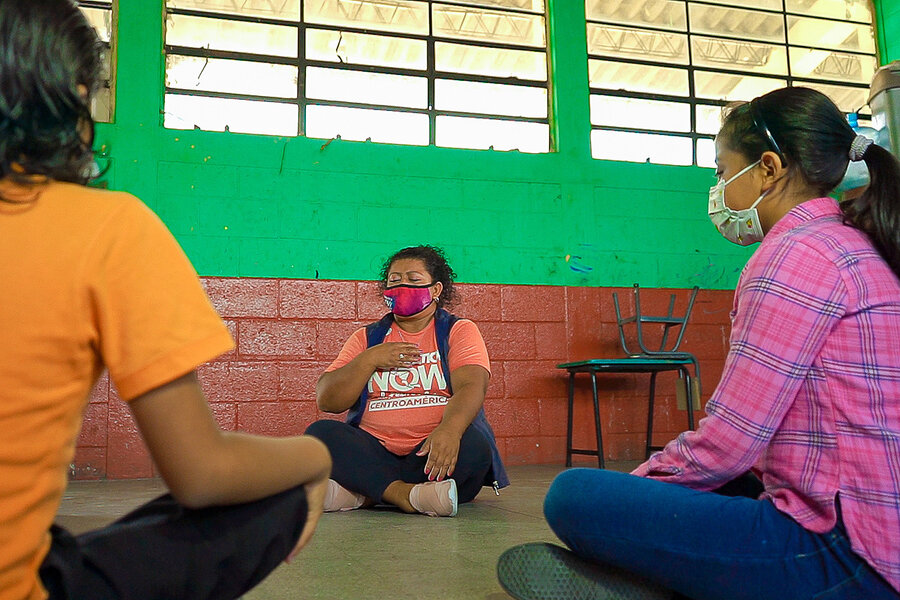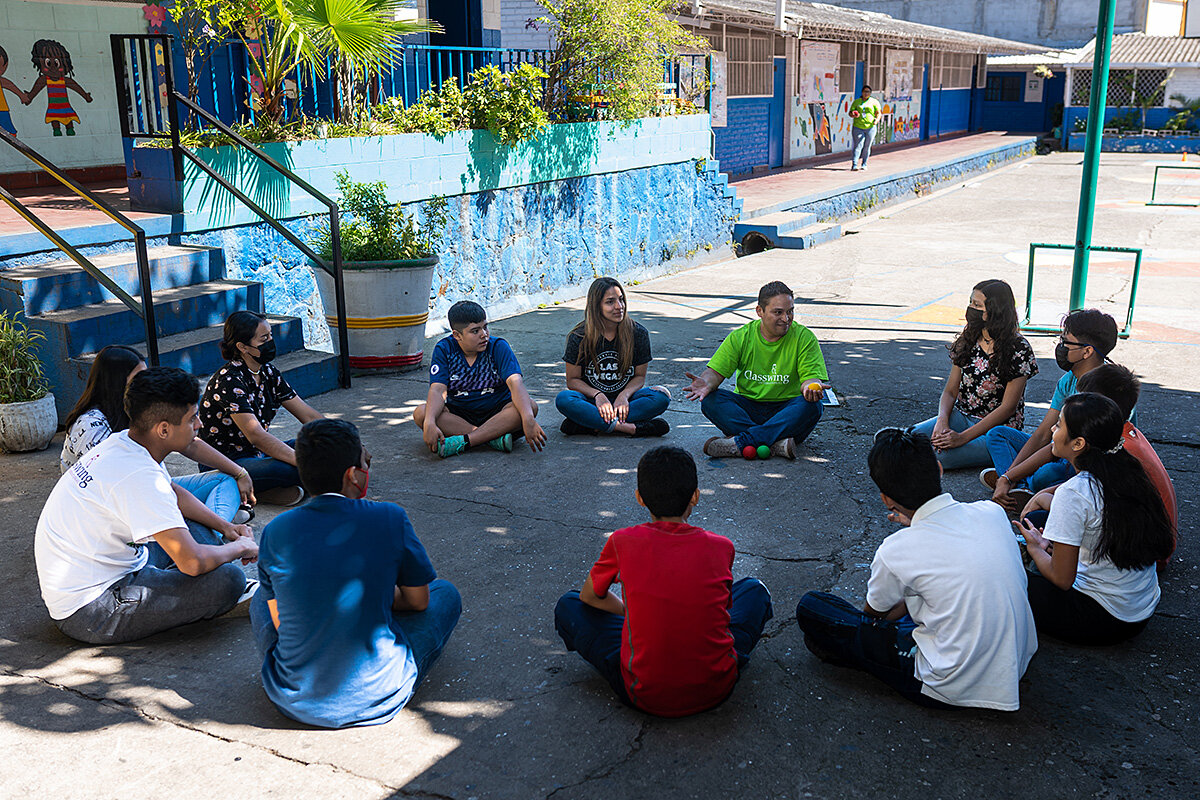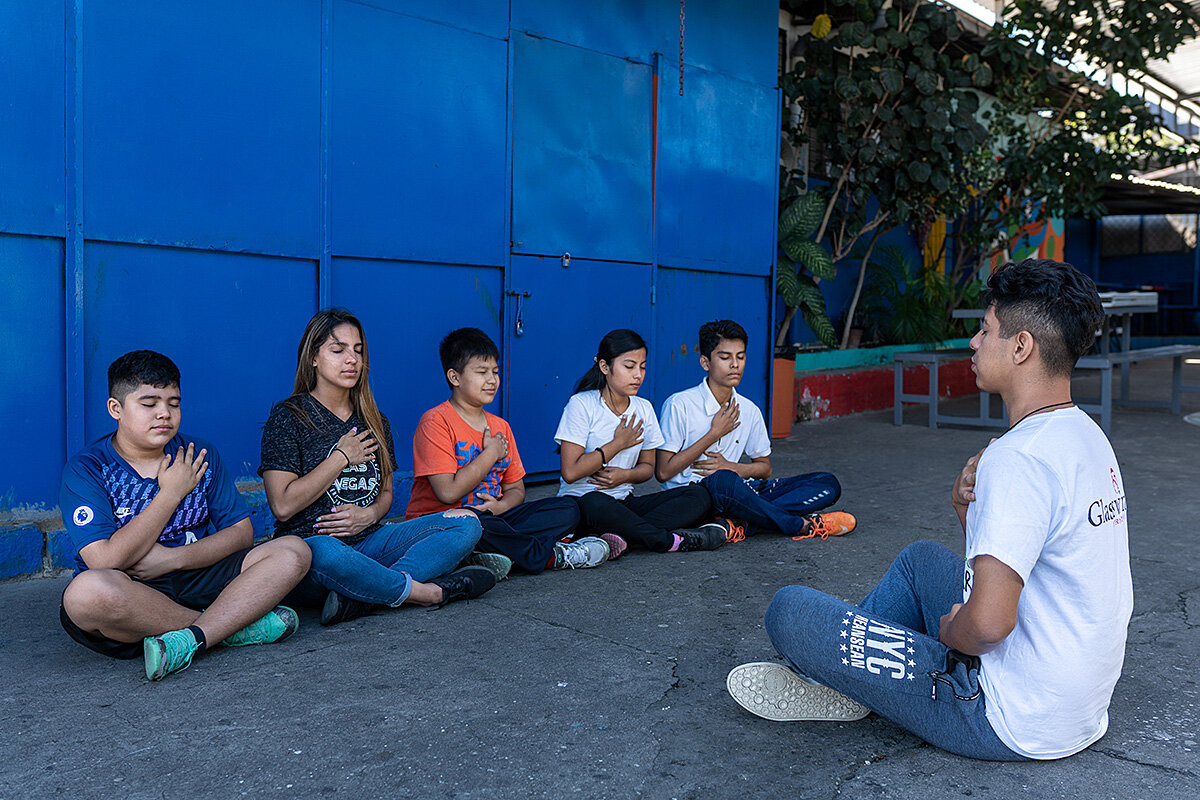Are falling murder rates enough to heal Central American societies?
Loading...
| SAN SALVADOR, El Salvador
Lizeth, an emergency room nurse at a major public hospital here, doesn’t flinch when she attends victims of violence. But her medical training did not include how to confront patient tears or silence or fear.
“Don’t worry, it will all be over soon,” she says she used to tell patients dismissively, thinking it helped them get through a tough moment. But after undergoing a mental health training for professionals steeped in violence and trauma, organized by a nongovernmental organization here, she’s changed her approach. Now she offers breathing exercises, tries to create a safe environment, and builds trust through listening.
Lizeth, who asked to use only her first name for security reasons, is joining a growing number of professionals reshaping mental health in a country still reeling from civil-war era trauma and dealing with more than a decade of widespread gang warfare.
Why We Wrote This
A story focused onHomicides have decreased across Central America in recent years, but healing society is about more than just reducing murders.
Homicides have decreased across Central America in recent years, in part thanks to improved policing and justice systems and controversial negotiations with gangs. But progress in mental health services has lagged – and without it, many say, these security gains could be short lived, given the link between trauma and violence.
Local and international organizations are increasingly incorporating mental health care and trauma response into their work. Teachers, police officers, lawyers, and medical professionals like Lizeth are asking tough questions about trauma in their day-to-day work. What impact have years of violence left on society? What would it take for people to actually feel safe in Central America? How can I be part of this solution?
“We’re not [used to] addressing trauma and mental health as a root cause of violence and understanding it as a key strategy to preventing the perpetuation of violence,” says Celina de Sola, co-founder and president of Salvadoran Glasswing, an NGO which runs mental health first-aid trainings like the one Lizeth joined in 2021.
“If you are exposed to violence, you’re more likely to either be revictimized or potentially perpetrate violence,” Ms. De Sola says. Investing in mental health is an “opportunity to…really prevent these patterns of violence.”
A long history
Civil society, community leaders, and regional governments, looking back at the end of the civil wars that devastated Central America in the 1980s, have noted a collective failure to discuss and treat trauma at the time. Some see direct links to the violence that overwhelms their communities today.
Poor mental health can manifest itself as difficulty interacting with others, problems concentrating at school, and trouble finding or succeeding at a job, says Tobias Hecker, a clinical psychologist at Bielefeld University, in Germany. It’s not often the outcome of one single event, but when challenges are ignored, “people cannot achieve many things in their daily lives,” Dr. Hecker says.
At an expansive clinic in Santiago de Maria, Usulutan, in eastern El Salvador, patients wait in chairs lined in neat rows for their turn to see doctors. The clinic opened in 2001 following an earthquake that devastated the area, and the town was a hotspot during the country’s 12-year civil war. Many patients are former combatants or had a relative killed or disappeared during that time. Despite these dark memories, past violence is not frequently discussed.
Aníbal Quijano, the medical director, says many patients come with physical ailments. But doctors are trained to dig deeper in order to understand if these could be related to past stress, such as the war or gang violence.
“We can’t neglect that a human being’s emotional, psychological, and mental needs have to be addressed,” Dr. Quijano says.
The clinic, run by U.S. nonprofit Americares, believes doctors must understand the patient’s full history to properly provide care: treating physical symptoms may be of limited value if the emotional distress isn’t addressed.
When the pandemic hit, this understanding of trauma’s role – past and present – led the organization to launch teletherapy, serving nearly 2,200 patients in the first seven months.
Breaking the cycle
Elubia Velasquez, a teacher in her late 40s in Villa Nueva, Guatemala, has lived through cycles of violence. She was sexually abused as a child, and her parents were “physically, verbally, and psychologically abusive,” she says. Guatemala’s 36-year civil war, which ended in 1996, served as the backdrop to her youth.
As an adult, the violence in her community evolved, and a new kind of fighting took over — criminal gangs went to war with each other for territorial control. In the early 2000s, up to 10 murders occurred per day in her community.
One afternoon is etched in her memory: Gunfire broke out near school and she and her students took cover. Suddenly, two brothers sprinted from their hiding place, and she followed them.
Across the street, she could see the boys’ mother had been shot. “When I heard the kids’ cries, I went up to them and hugged them,” she says.
Back then, Ms. Velasquez had no training to help support people experiencing such acute pain. She just followed her instincts.
She wanted her students to see a psychologist, but like many victims of violence in Central America, their family quickly fled. They could be killed if the murderer thought the kids could identify him or her.
A few years later, in 2017, something clicked for Ms. Velasquez. Her school received three weeks of training in psychological first aid from Glasswing. It’s a 4-hour-per-week program that works with first responders – defined broadly as anyone coming into contact with someone who may be traumatized – in helping people through the first moments of a distressing experience. It focuses on creating a safe environment and establishing calm.
Helping people feel safe during and after a traumatic event can reduce the chances of post-traumatic stress disorder, research shows.
“Now what I do is more intentional,” says Ms. Velasquez, who recently put her skills into action. She approached the father of an adolescent gunshot victim when he practically collapsed after seeing his child’s dead body.
Ms. Velasquez was stunned to see the victim was one of her students. “But I said to myself, ‘This is where I need to implement the protocol I’ve been taught.’”
She helped the father tell his wife what had happened and worked to calm him down through breathing exercises.
In 2022, Glasswing received a $42 million grant from the Audacious Project, a nonprofit affiliated with TED. The support will allow it to expand its mental health programs over five years across El Salvador, Guatemala, and Honduras, potentially reaching up to 9.7 million people each year.
Help for the helpers
Attending to emotional wounds isn’t limited to traditional mental health care. Impunity is sky high in Central America, where fewer than 10% of femicides are solved in El Salvador and Honduras, and fewer than 30% in Guatemala.
Merary Avila, a Honduran lawyer, says the women she represents often don’t feel safe until their abusers are behind bars. One of her clients attempted suicide three times while fighting for more than a decade for her rapist’s conviction.
When the court declared him guilty, she transformed, says Ms. Avila. “She had a different light in her eyes.”
And it’s increasingly understood that those whose work involves helping traumatized individuals need support.
“Sometimes people forget that doctors can leave the hospital and go home to the same community where there is violence, and they have to keep functioning as a caregiver,” says Nadia Guevara, a psychologist with the International Red Cross in El Salvador, which in 2018 began training doctors, nurses, and psychologists to manage their own stress.
“It’s hard for a victim to attend to another victim,” she says.
Despite growing awareness of the links between trauma and violence, government funding is scarce.
El Salvador created a public mental health unit in 2018, but experts say more attention is key. It dedicates 1.1% of its budget to mental health care, while Guatemala and Honduras allocate less than 1% and 2%, respectively.
Despite the challenges, there’s reason for optimism: The foundation is being laid and strengthened for better understanding the role of mental health care, says Ms. De Sola, from Glasswing.
“We’re all trying to figure this out together.”
– Reporting for this story was supported by the Alicia Patterson Foundation.







